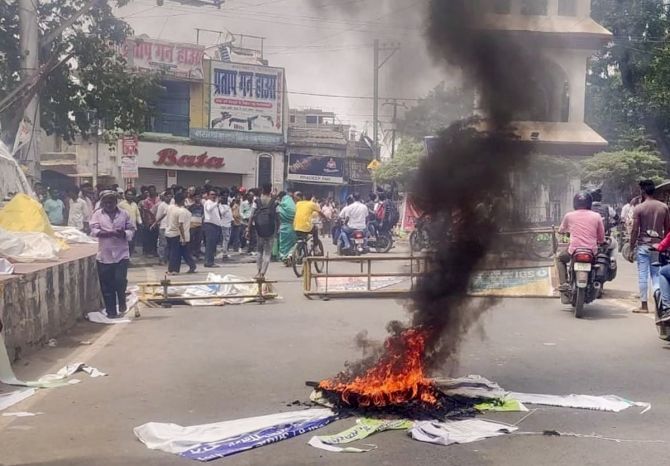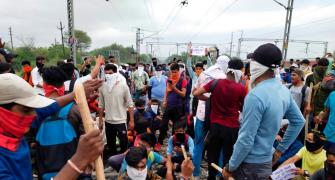There is disquiet and discomfort in the citizenry that can be touched and felt.
No one is talking, but then, the Indian voter has not talked much -- with the conviction that all that goes up has to come down, observes N Sathiya Moorthy.

For a ruling party which has supposedly got its grassroots-level contacts strong through the Rashtriya Swayamsevak Sangh cadre links, the Bharatiya Janata Party under Prime Minister Narendra Modi seems to be displaying signs of an increasing disconnect.
After the farmers' stir last year, the simultaneous eruption of the anti-Agniveer protests in many parts of the country shows what it means to introduce a scheme, if done without wider consultations, whatever be the ultimate benefits of such a scheme.
Both decisions displayed the kind of routine lethargic arrogance that sets in when the ruling party has a very strong parliamentary presence, and also suffers from a perverted sense of electoral dominance, which after a layer or two does not reflect the realities.

Like the Congress rival in its time, the BJP has failed to understand that a substantial section of the support base is not sold on its ideology, but has 'voted for change'.
This section is eternally restless for change, and keeps changing their electoral options at every turn.
They are unpredictable despite the best of strategies, despite the best of psephologists working for you. Full-stop.
It happened to Jawaharlal Nehru, over China, even if not on Jammu and Kashmir.
This was despite his inherent respect for democracy and dutiful conviction that he needed to keep the people abreast through Parliament and also through his periodic letters to chief ministers.
Indira Gandhi was at the peak of her political career, so to say, after trouncing all street-level opposition in the form of public sector employee protests and more so the unforgettable railway strike.
She did not bargain for the Emergency, which stood in her name. She lost and lost very badly.
Her diverse rivals could not hold the Janata experiment together, facilitating her return, but it was not the same again -- either for her, or for her party, or for the nation.
Today, with assembly polls in Modi's native Gujarat, Himachal Pradesh, later this year, and a few others next year, in the long run-up to the Lok Sabha polls in the summer of 2024, there is disquiet and discomfort in the citizenry that can be touched and felt.
No one is talking, but then, the Indian voter has not talked much -- with the fatalistic conviction that all that goes up has to come down, and with the uncanny realisation that at the end of the day, whoever it is, his political masters would have to come back to him for electoral endorsement, every five years.
Indira Gandhi's post-Emergency polls of 1977 remains standing proof.

Modi came to power in 2014, especially on the strength of the 20 per cent youth voters, who sustained their hope for 'change' (?) five years later in 2019, despite the vagaries of demonetisation and its inevitable fallouts.
Then came the avoidable 'long march' of all those youth -- men and women, mostly semi-literate rural population from central and north-east India -- owing to the Covid lockdown that was as unplanned as demonetisation.
Today, there is a substantial section of first-time voters, who did not know how the 'Congress maladministration' of the previous 10 years worked, or did not work.
Their vote will be based on their first-hand evaluation of what they see, hear and live with -- be it for the government or against the government.
This is precisely what happened to the UPA-II under Manmohan Singh in 2014, despite decent economic indicators.
More importantly, no psephologist has divined a meter to measure when exactly the voters' mood changes.
Often times, he comes up with early indicators closer to the elections.
Going by the ruling BJP's 2004 experiment, even the grassroots-level RSS organisation failed, and failed so very miserably.

It is easy for the Sangh Parivar's social media groups to dub the youth agitating over the Agnipath/Agniveer issue as anti-national and worse.
In Yogi Adityanath's Uttar Pradesh, the Supreme Court's intervening oral observations may or may not have halted the weekend's demolition of the homes of some of those protestors.
Yet, the easiest thing for them all is to dub the protestors as politically motivated and belonging to anti-BJP, anti-Modi political parties and social groups.
They need to remember that the voters, including the youth, have stuck with the BJP and Modi, not because of an abiding belief in the BJP's 'anti-national' rhetoric, which times go all the way up to the top, or comes down from there.
It's only an indication that the voter, especially the youth, are ready to give yet another chance to the rulers, and see how much they do, and how far do they go.
Once they are convinced that they have had enough of it all, they change -- and do not care for options, as is often believed.
There are lessons in elections 1996, which political parties still refuse to learn.
At the time, the common voter did not want the 'reformist' Narasimha Rao-led Congress, wherein the prime minister, and not the Opposition BJP, was exposing 'corrupt ministers'.
It then became easy for the BJP and a friendly media to 'expose' Rao's 'corruption' in the 'Lakhubhai Pathak case', based on the so-called testimony of a pickle-trader in the UK.
When the courts cleared Rao of any wrongdoing, he was no more the prime minister. Lakhubhai Pathak was dead and gone for a while.
But the people did not vote in the BJP automatically.
Rather, they did not approve of the Ayodhya demolition, or rather, the demolition-driven communal riots and consequent tensions in many parts of the country, especially in the Hindi belt.
The voter did not want the Congress, but was not ready to accept the BJP either.
S/he gave them enough numbers, which together did not add up to an absolute majority.
Post-poll, there was a Harkishen Singh Surjeet in the CPI-M who did cobble together a majority of regional parties with the 'outside support' of the Congress.
H D Deve Gowda became prime minister, followed by I K Gujral.
Even when the voter gave the BJP a fairer chance to form a government in 1998 and 1999, it was under test, under the check of regional parties, most of whose voter-base was traditionally 'socialist' and 'secular', and hence 'anti-BJP'.

The BJP should now be thankful that no critic of the Agniveer scheme, either from the armed forces veterans' clubs, or the political Opposition or social outfits, has branded the same as a government-funded project to train new-generation RSS cadres in military ways even if only for four years, and 'unleash' them into society.
The chances are that such depictions would be shouted down with the 'anti-national' chorus.
Even so, it is not a sin for the party in power to attempt such a course, only that the army veterans have a different view on the usefulness or otherwise of the scheme.
But the way the scheme has been packaged, and the abrupt way in which it has been presented to the youth -- which is the way the defence ministry is equipped and is also expected to do -- the announcement has only divided their ranks.
Increasing the upper age limit from 21 years to 23 years for first-year recruitment may have a message for first-time voters in 2024, so can the overnight decision to recruit a million government employees in the next 18 months.
But the ruling party may have to do much more than offer those jobs -- and even actually recruit them -- unlike in 2014, when a mere slogan 'achche din' and a new and convincing face of then Gujarat chief minister Narendra Modi alone was enough to make a difference to the BJP's poll fortunes.
The reasons are not far to seek.
Traditionally, price rise and non-availability of essential commodities are the only issue that has moved voters in every other election in this country.
This will be especially so when there is no shocking or surprisingly fresh issue or face in the election -- and 2024 promises to be one more of a boring and repetitive campaign.
For the ruling party, the Ayodhya temple, after the demolition and decision to build the temple may not hold much charm for the voter.
The party's long-held promises on Article 370, uniform civil code and the like have lost their sheen -- and more of the same does not excite even their cadres.
In its place, the 'Nupur Sharma-Naveen Kumar Jindal' kind of unanticipated controversies 'expose' the inherent 'ideological weaknesses' of a party when in power.
The hardliners core may not approve of the Modi government yielding to 'pressures' from distant West Asia, but they have little option but to vote the party and possibly his leadership, if he throws his hat into the ring, which is a given.
But that is not the case with the peripheral Modi voters, who do not belong in the core and do not have ideological commitments or inhibitions.
N Sathiya Moorthy is a Chennai-based policy analyst and commentator.
Feature Presentation: Rajesh Alva/Rediff.com









